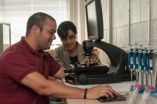(Press-News.org) EAST LANSING, Mich. — A team of researchers at Michigan State University has documented the step-by-step process in which organisms evolve new functions.
The results, published in the current issue of Nature, are revealed through an in-depth, genomics-based analysis that decodes how E. coli bacteria figured out how to supplement a traditional diet of glucose with an extra course of citrate.
"It's pretty nifty to see a new biological function evolve," said Zachary Blount, postdoctoral researcher in MSU's BEACON Center for the Study of Evolution in Action. "The first citrate-eaters were just barely able to grow on the citrate, but they got much better over time. We wanted to understand the changes that allowed the bacteria to evolve this new ability. We were lucky to have a system that allowed us to do so."
Normal E. coli can't digest citrate when oxygen is present. In fact, it's a distinct hallmark of E. coli. They can't eat citrate because E. coli don't express the right protein to absorb citrate molecules.
To decipher the responsible mutations, Blount worked with Richard Lenski, MSU Hannah Distinguished Professor of Microbiology and Molecular Genetics. Lenski's long-term experiment, cultivating cultures of fast-growing E. coli, was launched in 1988 and has allowed him and his teammates to study more than more than 56,000 generations of bacterial evolution.
The experiment demonstrates natural selection at work. And because samples are frozen and available for later study, when something new emerges scientists can go back to earlier generations to look for the steps that happened along the way.
"We first saw the citrate-using bacteria around 33,000 generations," Lenski explained. "But Zack was able to show that some of the important mutations had already occurred before then by replaying evolution from different intermediate stages. He showed you could re-evolve the citrate-eaters, but only after some of the other pieces of the puzzle were in place."
In the Nature paper, Blount and his teammates analyzed 29 genomes from different generations to find the mutational pieces of the puzzle. They uncovered a three-step process in which the bacteria developed this new ability.
The first stage was potentiation, when the E. coli accumulated at least two mutations that set the stage for later events. The second step, actualization, is when the bacteria first began eating citrate, but only just barely nibbling at it. The final stage, refinement, involved mutations that greatly improved the initially weak function. This allowed the citrate eaters to wolf down their new food source and to become dominant in the population.
"We were particularly excited about the actualization stage," Blount said. "The actual mutation involved is quite complex. It re-arranged part of the bacteria's DNA, making a new regulatory module that had not existed before. This new module causes the production of a protein that allows the bacteria to bring citrate into the cell when oxygen is present. That is a new trick for E. coli."
The change was far from normal, Lenski said.
"It wasn't a typical mutation at all, where just one base-pair, one letter, in the genome is changed," he said. "Instead, part of the genome was copied so that two chunks of DNA were stitched together in a new way. One chunk encoded a protein to get citrate into the cell, and the other chunk caused that protein to be expressed."
INFORMATION:
Additional co-authors include Jeff Barrick, University of Texas, and Carla Davidson, University of Calgary.
The research was funded in part by the National Science Foundation.
Michigan State University has been working to advance the common good in uncommon ways for more than 150 years. One of the top research universities in the world, MSU focuses its vast resources on creating solutions to some of the world's most pressing challenges, while providing life-changing opportunities to a diverse and inclusive academic community through more than 200 programs of study in 17 degree-granting colleges.
Evolution is as complicated as 1-2-3
2012-09-20
ELSE PRESS RELEASES FROM THIS DATE:
Study shows how consumers shift expectations and goals
2012-09-20
NEW YORK - September 19, 2012 - Sally and Harry are about to invest in their company's 401(k) plan. Sally chooses the best performing mutual fund, which has high risks but boasts a 25 percent year-to-date return. Harry, after considering the tradeoffs between risks and rewards, opts for a lower performing fund with an 8 percent year-to-date return. When they receive their next quarterly performance reports, both Sally and Harry discover that their funds have met their initial expectations. Are they satisfied? If not, why? And how could their levels of satisfaction be improved?
One ...
Using a laser to 'see' the smallest world
2012-09-20
(Santa Barbara, Calif.) –– A multi-university team has employed a high-powered laser based at UC Santa Barbara to dramatically improve one of the tools scientists use to study the world at the atomic level. The team used their amped-up electron paramagnetic resonance (EPR) spectrometer to study the electron spin of free radicals and nitrogen atoms trapped inside a diamond.
The improvement will pull back the veil that shrouds the molecular world, allowing scientists to study tiny molecules at a high resolution.
The team, which includes researchers from UCSB, University ...
UGA researchers boost efficacy of drugs by using nanoparticles to target 'powerhouse of cells'
2012-09-20
Athens, Ga. - Nanoparticles have shown great promise in the targeted delivery of drugs to cells, but researchers at the University of Georgia have refined the drug delivery process further by using nanoparticles to deliver drugs to a specific organelle within cells.
By targeting mitochondria, often called "the powerhouse of cells," the researchers increased the effectiveness of mitochondria-acting therapeutics used to treat cancer, Alzheimer's disease and obesity in studies conducted with cultured cells.
"The mitochondrion is a complex organelle that is very difficult ...
Johns Hopkins astrophysicist spies ultra-distant galaxy amidst cosmic 'dark ages'
2012-09-20
With the combined power of NASA's Spitzer and Hubble space telescopes as well as a cosmic magnification effect, a team of astronomers led by Wei Zheng of The Johns Hopkins University has spotted what could be the most distant galaxy ever detected.
Light from the young galaxy captured by the orbiting observatories shone forth when the 13.7-billion-year-old universe was just 500 million years old.
The far-off galaxy existed within an important era when the universe began to transit from the so-called "Dark Ages." During this period, the universe went from a dark, starless ...
The 'slippery slope to slime': Overgrown algae causing coral reef declines
2012-09-20
CORVALLIS, Ore. – Researchers at Oregon State University for the first time have confirmed some of the mechanisms by which overfishing and nitrate pollution can help destroy coral reefs – it appears they allow an overgrowth of algae that can bring with it unwanted pathogens, choke off oxygen and disrupt helpful bacteria.
These "macroalgae," or large algal species, are big enough to essentially smother corals. They can get out of control when sewage increases nitrate levels, feeds the algae, and some of the large fish that are most effective at reducing the algal buildup ...
The key to cooperation? Think fast
2012-09-20
It's an age old question: Why do we do good? What makes people sometimes willing to put "We" ahead of "Me?" Perhaps our first impulse is to be selfish, and cooperation is all about reining in greed. Or maybe cooperation happens spontaneously, and too much thinking gets in the way.
Harvard scientists are getting closer to an answer, showing that people's first response is to cooperate and that stopping to think encourages selfishness.
David Rand, a Post-Doctoral Fellow in Psychology, Joshua Greene, the John and Ruth Hazel Associate Professor of the Social Sciences ...
New cranial neural crest cell line developed
2012-09-20
New Rochelle, NY, September 19, 2012-- Researchers have successfully developed a stable population of neural crest cells derived from mice that can be grown in large quantities in the laboratory and that demonstrates the potential to develop into many different cell types needed throughout the body. This powerful new research tool for understanding stem cell biology and human development and disease is described in an article published in Stem Cells and Development, a peer-reviewed journal from Mary Ann Liebert, Inc., publishers. The article is available free on the Stem ...
GEN reports on growth of biobanking operations
2012-09-20
New Rochelle, NY, September 19, 2012— Many biotech observers maintain that the future of healthcare will largely be based on the field of personalized medicine, reports Genetic Engineering & Biotechnology News (GEN) (http://genengnews.com). Although drug discovery efforts require access to increasingly larger arrays of biosamples, demand is exceeding supply, fueling the growth of the biobanking market, according to a recent issue of GEN (http://genengnews.com/gen-articles/biobanking-confronts-growing-pains/4481).
"Personalized medicine is all about tailoring specific ...
Study: DNA barcoding can ID natural health products
2012-09-20
DNA barcoding developed by University of Guelph researchers has proven up to 88 per cent effective in authenticating natural health products, according to a new U of G study.
The study appears in the latest issue of Food Research International.
It's a crucial finding because the health product industry is under-regulated worldwide and mislabelling poses economic, health, legal and environmental implications, says study author Mehrdad Hajibabaei.
"Currently there is no other broadly applicable tool that can identify the species used in both animal and plant natural ...
ASGE initiative addresses endoscopy simulators for training and skill assessment
2012-09-20
OAK BROOK, Ill. – September 19, 2012 – The American Society for Gastrointestinal Endoscopy's (ASGE) Preservation and Incorporation of Valuable Endoscopic Innovations (PIVI) initiative addresses the use of endoscopy simulators for training and assessing skills in an article appearing in the September issue of GIE: Gastrointestinal Endoscopy, ASGE's monthly peer-reviewed scientific journal. This PIVI is one in a series of statements defining the diagnostic or therapeutic threshold that must be met for a technique or device to become considered appropriate for incorporation ...





